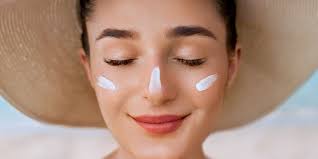
Ceramides in Skin Care
Ceramides are one of the most important ingredients in moisturizers. They are a type of lipid found in the stratum corneum layer of the skin that makes up the skin barrier alongside cholesterol and free fatty acids. There are many kinds of ceramides found in your skin and in a variety of barrier repair moisturizers, creams, serums, and more. They are most beneficial for sensitive, dry, mature, and combination skin types.
I explain to my patients that if you have dry skin, you need a ceramide containing moisturizer because your skin is not making enough ceramide.
This blog will explain what ceramides do in skin and how to find good ceramide containing moisturizers.
Best Ceramide Skincare Products
These are some of our favorite products that I recommend to my dermatology patients because they contain laboratory and plant-derived ceramides:
What are Ceramides?
Ceramides are a type of lipid found in the skin and brain tissue. The primary function of ceramide in the skin is as a part of the skin barrier. Simply put, without them, your skin barrier would be incomplete, allowing water to evaporate off the skin and irritants and allergens to enter the skin.
The same is true for cholesterol and free fatty acids, without them, your skin barrier would also be damaged.
For this to work properly, it must be added to the skin alongside cholesterol and fatty acids in an equal 1:1:1 ratio. (3)
Where do Ceramides Come From?
Ceramides are synthesized by the body under normal circumstances, but synthesis can be decreased which leads to dry skin. There are many types of ceramides, and each has different enzymes involved in their genesis. The primary enzyme involved in ceramide synthesis is called palmitoyl transferase. (4).
When the skin barrier is damaged, these enzymes go into overdrive to create new lipids for barrier repair. (5)
Ceramides used in skin care products are often harvested from microorganisms, animals, plants, or produced synthetically in a lab. For this reason, they are not always a vegan ingredient. Animal brain ceramides were often found in skincare products until mad cow disease became an issue. Then more ceramide skincare became laboratory made which is why pseudoceramides are now so popular. Skin care product labels do not indicate whether ceramides are of laboratory, plant or an animal origin, so if this is a concern to you, try to only use pseudoceramides instead like those found in the skin care brand Zerafite.
Benefits
Ceramides are one of the three primary lipid components of the skin barrier. Without an equal ratio of ceramides, free fatty acids, and cholesterol, the skin barrier is at risk of damage.
Ceramides are great at preventing transepidermal water loss (TEWL), a loss of skin hydration usually related to an impaired barrier.
They are also great for soothing inflammation, another issue often caused by damaged skin barriers.
Aging skin types benefit from these lipids because mature skin has a lower concentration of fats due to a decrease in ceramide production as we age.
Benefits of ceramides
Side effects
Applying ceramide products without properly maintaining a 1:1:1 ratio of fatty acids and cholesterol can result in an imbalance of skin barrier lipids. This imbalance can result in an unstable and fragile skin barrier, susceptible to further damage.
If you do not need moisturizing ingredients in your skin care, overusing them can result in a change to the microbiome of your skin. When skin is overly hydrated, there is a greater chance of bacteria growing on it.
When used properly, there are no notable risks associated with the use of ceramides in skin care.
Are they safe?
They are safe to use in skin care products, and are one of the most important ingredients in skin care, and crucial for maintaining the skin barrier.
Because it is such a ubiquitous compound in skin care products, organizations like the Cosmetic Ingredient Review Board (CIR) and the Environmental Working Group (EWG) have published extensive safety reviews on ceramides and other essential lipids.
The only reason not to include them in your skin care routine is if your dermatologist has advised against it, or if your skin is neither dry nor sensitive. Even in cases where you do not need barrier repairing ingredients, using them is not considered unsafe. There is no toxicity or mutagenic property associated with ceramides.
Which Skin Types should use Ceramides?
These ingredients are best for dry, sensitive, and/or mature skin types who have skin barrier related concerns.
If you have oily skin and a healthy skin barrier, you might not need these in your moisturizing products, but they are technically safe to use even if you don’t need them.
There are many types of ceramides, but the ones used in moisturizers are non-comedogenic, meaning they do not cause clogged pores on acne prone skin.
Ceramides for inflammation
Do you need ceramides in your skin care routine? Yes if you have dry skin. But many guess wrong so if you are unsure of if you are oily or dry we can help.
To find out if ceramides are right for your Baumann Skin Type, take our skin type quiz and get custom advice and a custom regimen made for you today!
What skin type am I?
Ceramides for Skin Conditions
Ceramides are mainly used to treat dry, rough and dull skin but they are also found in creams to treat sensitive skin and rosacea.
Inflammation
Ceramides are commonly used in products targeted towards inflammation because inflammation may be caused by a damaged skin barrier.
To restore the skin barrier, ceramides are often needed.
Studies have shown that inflamed skin shows a disruption of existing ceramides and subsequent lipid synthesis. (6)
The same study also found that patients with Atopic Dermatitis (eczema) demonstrate a much lower concentration of ceramides than healthy skin does.
If you are experiencing inflammation as a result of a damaged skin barrier, consider a barrier repair moisturizer loaded with ceramides, cholesterol, and free fatty acids.
Dry Skin
Dry skin types are at a greater risk of developing barrier related inflammation than oily skin types. This is because the sebum of oily skin types is robust enough to keep allergens, irritants, and even microbes off of it.
It is well known that a healthy skin barrier, is good at keeping moisture in the skin by preventing evaporation (transepidermal water loss).
Dry skin types are particularly vulnerable to environmental disturbances like pollution or low humidity, so ceramides are crucial to their skin’s protection. (7)
Aging Skin
Aging/mature skin often demonstrates a lower concentration of the essential skin barrier lipids because aged skin creates fewer lipids naturally than young skin. (8)
For this reason, it is important for dry, aging skin to use barrier repair products regularly to avoid inflammation and dryness.
Ceramides do not increase elastin or collagen, nor do they accelerate desquamation or bind free radicals; instead, ceramides simply help keep the skin barrier healthy which prevents problems commonly associated with aging skin such as dryness and inflammation.
Skin Protection
The skin barrier does more than just keep moisture in our skin, it also protects us from harmful environmental phenomena like pollution, microbes, extreme humidity, or low humidity. (11)
When your skin barrier has the right ratio of ceramides, cholesterol, and free fatty acids, it is better equipped to protect you.
Pollution can cause all kinds of damage to the skin like the development of free radicals; it is crucial to skin health to prevent this.
If you live somewhere with low air quality, using antioxidants alongside your ceramide barrier repair moisturizers is a good idea.
Types of Ceramides in Skin Care
All ceramides contain sphingosine. Sphingosine is a chain of carbon atoms with an amino acid attached. There are many different types of ceramides found in skincare products. They vary by the form of sphingosine and the type of fatty acid that binds it. There are at least 12 types of ceramides.
Ceramide 1
Ceramide 1 is a n-acylated sphingolipid made of phytosphingosine and an omega-hydroxy acid. It is also called Ceramide EOS.
Ceramide 1 contains a long-chain ester-linked fatty acid with 34-36 carbons acylated to sphingosine. It is one of the most abundant ceramides in healthy skin. Ceramide 1 plays a key role in maintaining skin barrier function and preventing transepidermal water loss. It acts synergistically with other ceramides to organize lipids into lamellar layers between corneocytes. Levels of ceramide 1 are significantly reduced in skin diseases like atopic dermatitis, contributing to impaired barrier function.
Ceramide 2
2-Oleamido-1,3-Octadecanediol, often referred to as Ceramide 2, Ceramide NS, or Ceramide NG, contains an alpha-hydroxy fatty acid, usually 30-34 carbons in length, amide-linked to a sphingoid base with 18 carbons. It represents around 5-10% of total ceramides in human stratum corneum. Ceramide 2 is a precursor in the metabolic pathway that produces some of the extra-long-chain ceramides like ceramide 1. Along with other ceramides, it contributes to the formation of lamellar membranes for healthy barrier function. Some studies have found increased levels of ceramide 2 in conditions like atopic dermatitis, perhaps due to disruption of the pathway to produce very long-chain ceramides. More research is still needed on the specific functional roles of ceramide 2 in normal and diseased skin.
Ceramide 3
Ceramide 3 is also known as ceramide NP, N-stearoyl phytosphingosine, or 1,3,4-octanediol. Ceramide 3 contains a 24-carbon fatty acid acylated to phytosphingosine. It is an important component of the skin barrier, working together with other ceramides to form lamellar layers that lock in moisture. Application of ceramide 3 has been shown to improve skin hydration and restore barrier function in irritated or damaged skin. Like ceramide 1, levels of ceramide 3 are often decreased in conditions like eczema and psoriasis.
Ceramide 4
Ceramide4, also known as Ceramide NP, contains a normal chain length (16-18 carbon) fatty acid amide-linked to phytosphingosine. It makes up around 4-7% of total ceramides in human stratum corneum. With its relatively small hydrophobic regions, ceramide NP allows for tight packing between adjacent ceramide lipids and contributes to the formation of lamellar membranes. Levels of ceramide NP tend to be decreased in conditions like eczema and psoriasis that have impaired barriers. Supplementing skin care products with ceramide NP can help restore normal stratum corneum lipid composition and organization.
Ceramide 6-II
Ceramide 6-II is also known as Ceramide AP. Ceramide 6-II has a fatty acid with 16-18 carbons amide-linked to a sphingoid base with 18 carbons. It represents around 7% of stratum corneum ceramides. Along with other ceramides, 6-II contributes to the organization of intercellular lipids into lamellae, which is crucial for permeability barrier function and preventing water loss. Reduced levels of ceramide 6-II could impact barrier integrity.
Ceramide 8
Ceramide 8, also known as Ceramide EOP, consists of a very long chain 30-32 carbon omega-hydroxylated fatty acid attached to 6-hydroxy-sphingosine. It represents about 1-2% of total ceramides in human stratum corneum. The unique structure of ceramide EOP allows it to strongly associate with other stratum corneum lipids, enhancing lamellar membrane integrity for optimal barrier function. Decreases in ceramide EOP levels have been associated with inflammatory skin conditions like psoriasis and eczema that have permeable barriers. Supplementing skin with ceramide EOP has been shown to improve hydration and barrier function. Overall, ceramide EOP plays a key role working synergistically with other ceramides to maintain moisture retention and skin integrity.
Ceramide 9
Ceramide 9 is also called N-lignoceroyl sphingosine and Ceramide EOS or Ceramide NS. Ceramide 9 consists of a very long chain 30-32 carbon fatty acid attached to sphingosine. It makes up just 3-5% of stratum corneum ceramides. The long hydrophobic fatty acid chain allows ceramide 9 to pack tightly with other barrier lipids, strengthening the permeability barrier. Decreases in ceramide 9 are associated with skin diseases like psoriasis that have impaired barrier function. More research is needed on the specific functions of this long chain ceramide.
Phytoceramides
Ceramides in skin care are often animal derived. Pseudoceramides are usually made in the laboratory. There are some ceramides that are plant derived.
Phytoceramides are composed of various plant-derived sphingoid bases attached to fatty acids. They are structurally similar to stratum corneum ceramides.
Common plant sources of phytoceramides include:
wheat
rice
sweet potato
corn
soy
konjac
Supplements and skin care products with phytoceramides derived from these plant sources helps to restore ceramide content in the skin barrier. Clinical studies (16-20) have demonstrated that applying products with wheat and rice derived phytoceramides improves symptoms like dryness, irritation, and transepidermal water loss. Over time, oral and topical phytoceramides help strengthen the barrier integrity of the stratum corneum.
Pseudoceramides
Pseudoceramides are a classification of synthetic ingredients that fulfill the same functions as naturally occurring ceramides. (9)
In a sense, they are to ceramides what beta-sitosterol is to cholesterol; meaning it’s a vegan, synthetic alternative.
Pseudoceramides are increasingly popular as treatment options for conditions like eczema and other dryness/inflammation based concerns because they are not animal derived.
Pseudoceramides work best when used in a 1:1:1 ratio with cholesterol/beta-sitosterol and free fatty acids.
Pseudoceramides are interesting because their synthetic nature allows for customization in the lab, meaning they can be tailored to exhibit very specific properties in products. (10)
If you need a barrier repair ingredient, but want to avoid potentially animal derived ingredients, consider pseudoceramides.
Ceramides for Environmental Damage
Foods High in Ceramides
Eatingceramide-rich foods can help support production of stratum corneum ceramides from within the body. This dietary approach complements topical use of ceramide skin care products. Eat a diet high in these foods that have a lot of ceramides:
Soy products – Tofu, edamame, soy milk, and tempeh
Wheat products – Bread, crackers, wheat bran and wheat germ provide phytoceramides.
Konjac root – This contains glucomannan, a dietary fiber that can yield high amounts of ceramides.
Eggs – Egg yolks contain sphingomyelins which are precursors to ceramides.
Brown rice – Contains cerebrosides that can transform into ceramides.
Spinach – A good vegetable source of cerebrosides which can metabolize into ceramides.
Milk and dairy – Contains sphingomyelin and glycosylated ceramides that provide ceramides.
Red meat – Beef, lamb and pork offer some dietary ceramides.
Fish – Some fatty fish like salmon and mackerel provide ceramide precursors.
Let us help you find the best skin care products. Once you take the quiz, you can shop using your Baumann Skin Type. Our advice will help you build a skin care routine for your skin type!


